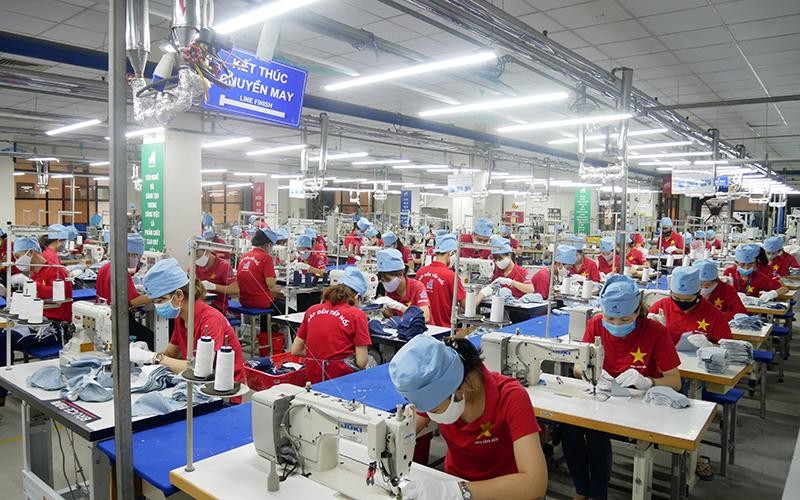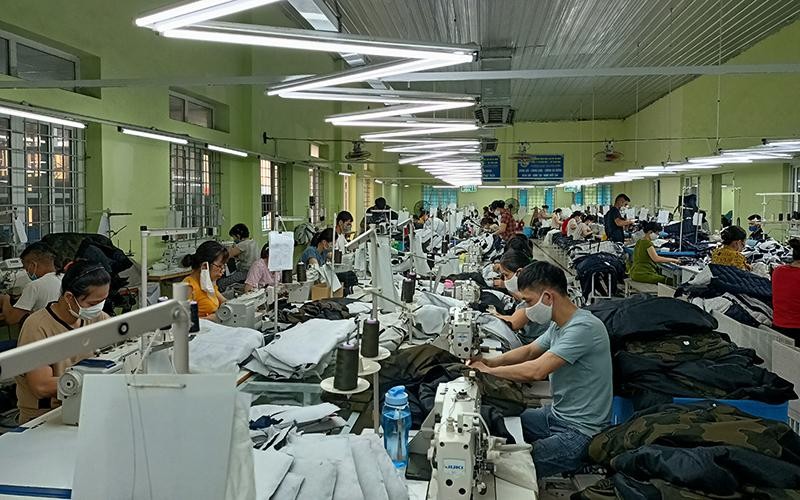
Producing garments for export at Garment Corporation 10.
In order to overcome difficulties, businesses need to flexibly deploy response solutions and soon complete their set goals.
Contrary to the positive growth signals in the past nine months, textile and garment enterprises are currently experiencing a shortage of orders, facing the risk of reducing working hours and stopping operations. Many businesses have to accept low-priced orders to maintain production.
"Measure" orders
Deputy General Director of Garment 10 Corporation Bach Thang Long said that in the first months of the year, the production and business situation of the unit achieved good growth with total revenue in eight months of more than 3,128 billion VND, an increase of 150 % compared to the same period in 2021. However, things almost reversed in the last three months of the year when the number of new orders reached the end of October; From November onwards, the number of orders is about 30 to 35% missing. Not only "measure" each order, but many units are also forced to lower prices by 20-30%, which forces businesses to calculate and receive goods to maintain labor resources and stabilize production.
The main reason is due to high inflation in countries leading to a decrease in consumer demand. Big brands are facing large inventories. Even, many orders have been completed, but customers ask to delay and extend the delivery time because there is no warehouse. That shows that businesses are facing many difficulties before unpredictable fluctuations of the market.
According to Deputy General Director Bach Thang Long, in order to achieve the target of total revenue of 3,800 billion VND, Garment 10 has flexibly deployed many adaptive solutions such as reducing costs, accelerating the search for opportunities. , expanding customer partners and reducing working hours, while boosting investment and improving productivity to increase competitiveness in the market. However, it is only in the short term, because businesses are having to balance and take the accumulated part of the past eight months to maintain production and ensure income for employees. If the situation continues for a long time, then the enterprise will be more exhausted, not having enough resources to stabilize production.
Similarly, Chairman of the Board of Directors of Hung Yen Garment Corporation (Hugaco) Nguyen Xuan Duong affirmed that the textile and garment industry at the end of the year is "hungry" for orders, many businesses have to "eat" month by month when most Only received orders until the end of October. From November and December, difficulties continued due to the situation of countries around the world facing high inflation leading to a decrease in purchasing volume. If in the past, customers often ordered for the whole season, now they still have to listen to the market and place orders in a short time after carefully analyzing and studying market trends.
Chairman of the Board of Directors of Hugaco Nguyen Xuan Duong also said that, in addition to a number of units that had enough goods at the end of the year, most of the rest only reached about 50-60% in November and December. still waiting, negotiating, looking for customers. Although the revenue in the past nine months still achieved good results, increasing by about 10% over the same period, in the face of such difficulties, the enterprise determined that it had to take profits, the accumulated part to make up for the shortfall. . At the same time, in the coming months, it is determined that competitive prices, lower prices are still accepted to do, in order to share difficulties with partners and customers.
Sharing the same mood, General Director of Ho Guom Group Joint Stock Company Phi Ngoc Trinh said that the production and business situation of the unit in eight months was relatively favorable, revenue increased by about 3% over the same period last year. 2021. From September onwards, the number of orders is in short supply, down 30% compared to every year, which has pushed businesses into a very difficult situation. To maintain operations, businesses must cut costs and increase productivity by investing in modern machinery and equipment to meet the increasing requirements of customers.
Catch the market trend
According to Vice President and General Secretary of the Vietnam Textile and Apparel Association (Vitas) Truong Van Cam, the total export turnover of Vietnam's textiles and garments in the past eight months reached nearly 31 billion USD, up 18% over the same period in 2021. This is a positive signal when the trade surplus reached 13.3 billion USD and is the premise for the industry to reach the target of 43.5 to 44 billion USD for the whole year. However, due to the unpredictable situation of the market along with unpredictable developments of the epidemic, the GDP growth of major markets that Vietnam exports to such as the US, EU, Japan, Korea,... did not meet expectations, especially high inflation has had a strong impact on people's lives, causing a sharp drop in consumption demand.

Production activities at Nam Dinh Textile and Garment Joint Stock Corporation.
On the other hand, due to the military conflict between Russia and Ukraine, the prices of raw materials, fuel, transportation costs increased, etc., which increased the costs for businesses. Currently, many businesses have to accept orders that they shouldn't have received before due to low unit prices, on average down to 30-40%, even with orders down to 50%, but businesses still have to receive mainly to maintain maintain production and ensure jobs for workers. In order to cope with difficulties, businesses must flexibly deploy solutions to improve productivity, catch up with market trends, invest in machinery and technology, and transform green to adapt to the requirements of brands. , market.
Referring to market signals, General Director of Vietnam National Textile and Garment Group (Vinatex) Cao Huu Hieu said that the unit's revenue in the past eight months has completed more than 70% of the plan, an increase of more than 20% compared to the previous year. same period in 2021; profit completed 120% of the year plan. This is a positive result, but with the current fluctuations of the cotton market, the world is facing high inflation,...
Therefore, Vinatex must be very cautious, forecast closely to the market and have optimal solutions to keep the achieved results. In which, businesses need to focus on tight management, maximum cost savings at all stages; need financial control, smooth cash flow, and early data to be able to provide internal support to units in difficulty.
Due to low world demand, textile and garment enterprises need to take full advantage of the opportunity to use each other's products, especially sewing and knitting using fabrics of knitting units with the general regulation of the Group. The goal is to win orders and positions in the supply chain.
Units need to thoroughly digitize general data, especially inventory data, in order to reduce inventory; can make joint purchase and share with the whole Group, limiting individual buying according to the needs of the volatile market. In addition, it is necessary to specifically calculate the impact of the business plan, sales, the damage in case the machine is not running at capacity; Taking risks with consideration, maintaining long-term goals, keeping employees and traditional customers, etc.
Chairman of the Board of Directors of Vinatex Le Tien Truong added that, among textile and garment exporting countries, Vietnam is the country with the earliest policy of opening up to normal operations compared to Bangladesh, India and China. Therefore, in the first months of the year, businesses have made good use of opportunities, abundant orders, good business results, and high efficiency.
However, the policy areas that have been implemented early to benefit Vietnam's textile and garment industry and other export industries have also been applied by other countries. Countries that have opened up, returned to normal production, and implemented measures to support interest rates for businesses such as Bangladesh, India, etc.
Meanwhile, the world market had the opposite trend, suddenly becoming "cold", world demand dropped sharply due to the world economic recession and high inflation. Therefore, businesses must monitor every day, every hour to adjust to maintain efficiency, avoid losses to be able to endure in the long term. The State and ministries and branches need to have mechanisms and policies to support enterprises to promote investment and development; Especially, reducing taxes, fees, and interest rate support in short-term loans to buy raw materials in foreign currencies will contribute to solving difficulties for textile and garment enterprises in the current period.
Article and photo: Minh Duc
https://nhandan.vn/nganh-det-may-no-luc-vuot-kho-post716426.html
nhandan